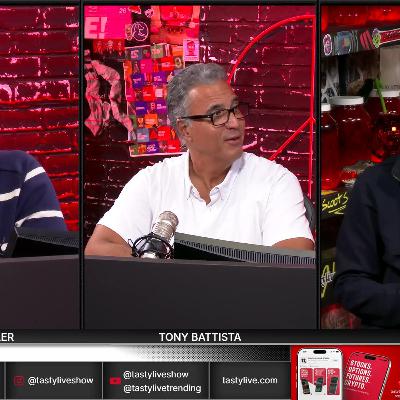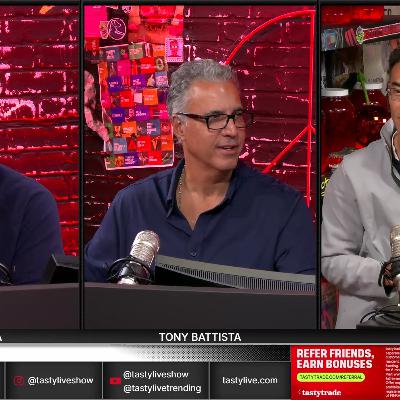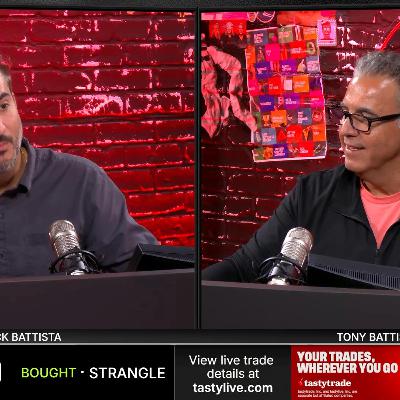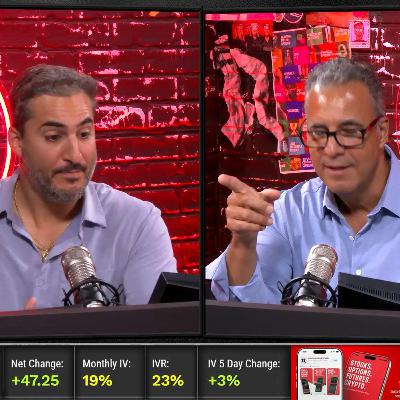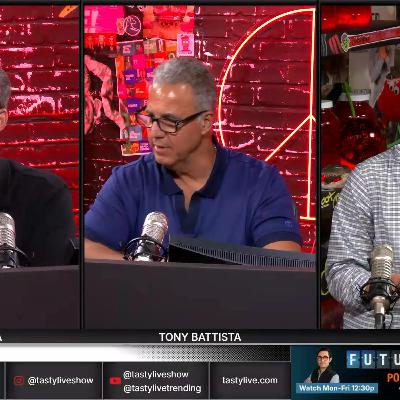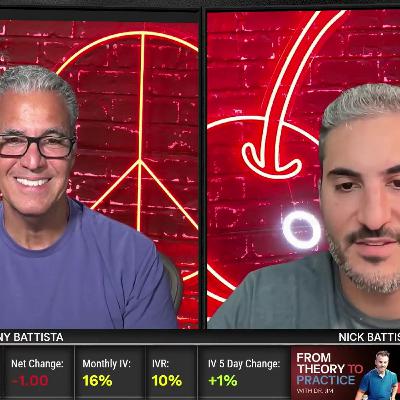Discover tastylive: Last Call
tastylive: Last Call

2260 Episodes
Reverse
Hosts Tony and Jamal welcomed researcher Kai to discuss a week where Fed policy overshadowed market action, with the 25bp rate cut accompanied by hawkish commentary that sent December cut expectations plummeting from 90% to 67% (now 69-70%). Kai noted the Fed Watch tool has been highly accurate historically when above 65%, suggesting December cut remains likely but not guaranteed. The government shutdown entered its sixth week (31 calendar days) approaching the 2018-2019 record of 34 days, with less than 25% probability of resolution this week and 50% expecting it to extend past November 16th. Global markets rallied with all nine major indices up, though US gains were modest compared to Asian markets led by Japan and Hong Kong (both up 30%+). The earnings picture showed last week's major names delivering more red than green among liquid stocks, with the season now perfectly balanced at 50% winners/losers and zero average returns across 1,200+ companies. Upcoming week features busy slate including Palantir and HIMS today, Uber/Shopify/Spotify tomorrow, and AMD Tuesday as the standout.
Hosts Nick and Tony explored why leveraged ETFs consistently underperform their intended multiples over time, despite $120 billion in assets and explosive growth since 2020's market recovery. The analysis demonstrated how daily resets create asymmetric compounding - using a three-day example where Tesla went -3%, -3%, +6.3% (ending flat) while the 2X ETF went -6%, -6%, +12.6% (ending down 50 basis points). This "volatility decay" or "drag" means investors need V-shaped recoveries rather than grinding moves, as illustrated by Tesla's 22% annual gain producing a -7% loss in TSLL after dividends. The segment emphasized these products are designed for hours or days of trading, not buy-and-hold strategies, with particular warning about XIV's 2017 collapse when volatility finally popped after two years of daily declines. New single-stock ETFs tracking Tesla, NVIDIA, and MicroStrategy at 2-3X leverage now dominate the space, with some incorporating covered calls for yield, though hosts noted sophisticated traders prefer implementing these strategies themselves rather than paying management fees.
Hosts Nick and Tony welcomed researcher Kai to preview the busiest earnings week of the season with over 450 companies reporting (350+ last week alone), flipping the winner-loser ratio from negative to 52% winners with average 0.5% positive returns. Last week's volatility produced eight stocks with double-digit post-earnings moves including GM up 20%, ISRG up 19%, and Decker's down 13% - representing 2-3x expected moves and creating Kai's "busiest chart ever" in two years of research corners. The historic nature was emphasized when GM and Ford topped mover lists, which Nick noted signals "things getting a little crazy" as these aren't typical market leaders. Broadcom's inclusion in the Mag 7 (replacing Tesla at $1.4T vs NVIDIA's $1.6T) highlighted the AI trade's dominance, with AVGO surging from under $200 to $360. The upcoming week features critical events including Fed meeting Wednesday (98.5% expect 25bp cut - "given" scenario), potential Trump-Xi meeting in Asia driving soybean rally, and major earnings Wednesday-Thursday including Meta, Microsoft, Google, Apple, Amazon, and Coinbase.
Hosts Nick and Tony analyzed Japan's political and monetary shifts driving extreme yen volatility, explaining how Japan's new prime minister favoring government spending and looser budgets weakens the yen through higher bond issuance and money printing, similar to US dollar's 15-20% annual decline. The carry trade mechanics were illustrated: investors borrow yen at low rates, exchange for US dollars, invest in higher-yielding US bonds, and profit from the 1-2.5% spread while benefiting from yen depreciation when converting back. This creates a self-reinforcing cycle that continues "until something inevitably blows up" like August's carry trade unwind that impacted global equity markets. The discussion emphasized that content typically follows moves rather than predicting them, with the analysis highlighting how cheap yen funding affects not just Japan-US flows but also supports global liquidity as investors use yen loans to buy emerging market bonds and equities, creating trades highly sensitive to policy shifts that can quickly reverse.
Hosts Nick and Tony explored forward curve mechanics as markets rallied sharply (E-mini S&P +46, VIX collapsing to 19.76 from over 22). The segment distinguished between equity IV curves that highlight event-driven volatility like Tesla's October 22nd earnings spike, and futures forward curves that reveal macro themes through contango (weak current demand) or backwardation (strong current demand). Nick used Tesla's curve to demonstrate how front-month IV spikes before earnings then collapses post-event, while the natural gas curve illustrated extreme seasonality with winter months trading $1 premium (nearly 4.25 vs 3.30 spot). The critical insight was that futures options expire to specific futures contracts with their own pricing along the curve, making it dangerous to buy far-dated options assuming "cheaper" strikes without understanding curve positioning. Nick aggressively managed winners, taking Oracle strangle profits after weekend vol collapse and AMD gains, while noting gold's reversal (+$100 from session lows) helped his short positions including a 3,800-3,850-3,900 butterfly that had been 300 points in the money.
Hosts Nick and Tony welcomed researcher Kai to discuss a volatile week where major indices gained 2-3% (buying the dip from prior Friday's selloff) while VIX closed at 20.8 after touching nearly 30 intraday Friday. The conversation opened with banter about Nick's weather forecasting obsession and Kai's joke about it being a sign of aging. The government shutdown analysis revealed it will surpass the 1995 Clinton-era shutdown length by Tuesday, with CPI data potentially still releasing this Friday and the White House suggesting it "could end this week." Gold emerged as the standout with 94% IVR and people "posting gold trades everywhere" (typical market top signal per Nick), prompting Nick to sell micro gold futures Friday with successful scalps. The earnings season stats showed 100+ companies reporting with 55% losers versus 45% winners averaging -0.2% returns, setting up a busy week with Netflix, Tesla, IBM, and other major names. Kai emphasized this represents the "sweet spot" for volatility - not super low or super high but right in the middle where premium looks juicy.
The skew index measures sentiment and tail-risk by tracking out-of-the-money puts and calls. It’s often seen as a fear gauge, but it reflects both upside and downside risk.
Typical values range from 110–180, with 146 as average. Historically, skew has shown little ability to predict SPX returns.
However, extreme skew levels often align with larger VIX moves. When VIX is low (10–14), surprises cause sharper reactions than in high-volatility periods.
Skew is worth monitoring, but offers limited trading signals. Key takeaway: high volatility overstates risk; low volatility understates it.
Hosts Nick and Tony discussed the historic precious metals rally while managing through a sharp market sell-off, with Nick closing profitable positions including a NVIDIA put diagonal that went from $7 to $10. The gold segment revealed the accelerating pace of thousand-dollar moves (only 207 days from $3,000 to $4,000 versus years for prior moves), though both hosts admitted hating trading these markets despite increased activity over the past two years. The correlation analysis showed gold and silver move together (0.8 correlation) but have near-zero correlation with S&P 500 on a day-to-day basis, with silver behaving more like a "risk-on" asset due to its industrial demand. Nick capitalized on volatility expansion, taking $60 out of an SPX zero-day spread despite E-minis recovering $10 from entry, demonstrating the power of vol contraction. The session ended with Nick closing profitable TastyFX positions in EUR/JPY and GBP/JPY after taking significant pain, while noting oil's decline to $58 (lowest since April/May) and emphasizing the need to actively trade this volatile environment.
In today's episode of Option Jive, the hosts delve into the strategies of trading SPY, contrasting short puts with buying shares. They present data spanning five years to illustrate performance dynamics, particularly in different volatility regimes. Learn how to navigate market conditions and discover the unique advantages and risks inherent in each trading approach. Tune in to enhance your trading strategy!
Hosts Liz and Tony welcomed researcher Kai to dissect Friday's dramatic sell-off that erased the entire week's gains, with breaking news of OpenAI-Broadcom deal sending AVGO up $40 to $360. Liz admitted eating her words after declaring markets "complacent" at 9:59am just before the crash, noting there was "no buying pressure at all" after 10am. The Friday move sent expected moves surging from 1.1% to 2.5% for the current week (166 points), with IVR jumping across all asset classes - especially gold and Bitcoin which showed double the S&P's volatility expansion. Kai explained crypto's notoriously higher volatility (7% Bitcoin move wasn't even top 10 percentile historically) while noting the 18% intraday plunge wiped out heavily leveraged accounts. Liz finally celebrated her gold bullishness after 22 years of ridicule as the metal broke $4,000, while the upcoming week features major bank earnings starting Tuesday morning (JPM, GS, C, WF) and TSM Wednesday, with expiration week historically showing 16-up/11-down pattern favoring bulls into Friday.
Utility stocks offer essential services like electricity, water, and gas, presenting a defensive option for investors seeking lower volatility. These stocks typically feature higher dividend yields with current annualized yields ranging from 2.7% to 4.3% and low 30-day implied volatility.
XLU, a popular utilities ETF, demonstrates lower correlation to the broader market and smaller percentage swings during both rallies and drawdowns. While utilities can be negatively impacted by rising interest rates due to their high debt levels, they may become more attractive as rates decrease.
With low correlation to both equities and bonds, utilities can effectively diversify portfolios.
In this segment, hosts discuss three approaches to achieving neutrality in options trading: delta neutral, price neutral, and equidistant strategies. Delta neutral positions have equal put and call deltas, with delta serving as a probability proxy for options expiring in-the-money. Price neutral strategies involve options with approximately equal prices, indicating balanced tail risk expectations. Equidistant strategies place strikes at equal dollar amounts from the current price. Rolling positions serves as a defensive tactic when market movements create unwanted directional exposure, effectively "keeping the dream alive" while managing risk.
Hosts Nick and Tony welcomed researcher Kai to discuss a week where government shutdown fears proved unfounded as all indices hit new highs, with Kai expressing frustration about missing directional moves. The conversation included Kai's FOMO over a poor man's covered call in AMD that capped gains when the stock surged $40-50 past his short calls, highlighting the psychological challenges of position management. Markets followed the "sell Rosh Hashanah, buy Yom Kippur" pattern perfectly, with the October 1st dip providing the only selling opportunity before relentless upside. Copper's 7% weekly surge represented a rare event (less than 2% probability), though both hosts avoid trading the volatile futures contract after August's limit up/down chaos. The standout observation was VIX holding steady or rising slightly as markets climbed - potentially signaling coiling action, with Nick noting a significant down move with elevated volatility would be the first real warning sign for bears.


